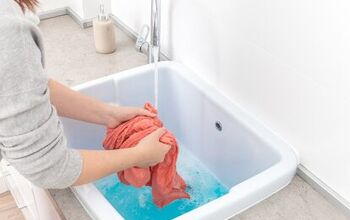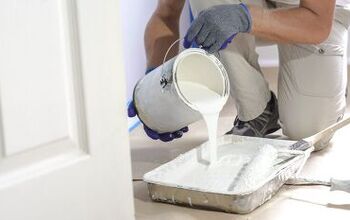Can You Add Water To Paint?

If you found the perfect color paint but find it too thick to paint with, you might wonder how you can make it more workable. Or perhaps you have an old can of paint you need to use for touch ups, but find that over time, it has thickened up too much to use. Either way, this thick paint will have you wondering if you can add water to your paint, and if so, how much?
You can add water to latex and other water-based paints. This is common when you need a more workable paint, if you are using a paint sprayer or are looking for a softer and lighter finish. You cannot, however, add water to oil-based paints. You need to use paint thinners or mineral spirits for these types of paints. Adding water to paint will often lighten its color.
If you need to know what to do with your thick paint, we have outlined your options below. The good news is that in some cases, a little bit of water and mixing will do the trick.
In other cases, adding water to paint can have undesirable consequences. Keep reading to find out whether or not you should add water to paint for your specific home improvement project.
Can You Add Water To Paint?
The short answer to the question of whether or not you can add water to paint is — sometimes. There are all sorts of different types of paint, and they are made differently with different ingredients.
If you have a water-based paint, like latex paint or even acrylic paints, then it is possible to add water to these paints without destroying them. Keep in mind, however, that just because you can add water, it doesn’t mean you should.
As we will detail further in this article, adding water to paint can change its structure, finish and color. This is not always desirable.
Oil-based paints, on the other hand, should never have water added. Oil and water, as you likely know, do not mix. So, adding water to oil-based paint will mess up the structure of the paint.
If you need to thin oil-based paints you need to use paint thinner or mineral spirits specifically designed to thin those types of paint.
What Kind Of Paint Can You Add Water To?
You can add water to water-based paints including latex paint and acrylic paint. Latex paints are almost 40% water already, so water makes for a natural thinner. If you need to thin the paint out, try using one half-cup of water per each gallon of paint.
Adding water to acrylic paints is also possible. Keep in mind, however, that adding water to acrylic paints is likely to significantly alter the finished product. This can result in a more matte finish and an almost water-color look to the painted surface.
Pro Tip: Make sure you use the same water-to-paint ratio for your entire project to ensure consistent results, as adding water to the paint can alter the paint’s finished appearance.
Examples Of When It Is A Good Idea To Add Water To Paint
When you Need More Workable Paint
One of the most common reasons to add water to a water-based paint is to thin it out and make it more workable. If you are trying to paint multiple very thin coats, for example, you might need a slightly thinner paint to work with.
If A Longer Drying Time Is Preferred
Sometimes you want your paint to dry a bit slower. This can happen in hot and dry climates. If you add a bit of water to your paint, it will take longer for the paint to dry, making it easier to go over the areas for a smooth and seamless finish.
To Lighten The Color
If you love a paint color but want it to be a bit lighter or muted, you might want to add some water. Adding water (especially more than normal) will lighten your paint and soften the finish.
This works well for that washed-out beach and bohemian look. It also works great when you are trying for a distressed vibe on furniture.
Using Paint In A Paint Sprayer
Sometimes when you use a paint sprayer, the water-based paint is too thick. This can give you patchy results and a malfunctioning paint sprayer. So, a thin and perfect consistency is crucial when using a paint sprayer.
Reasons Why You Should Not Add Water To Paint
It Can Affect The Color
If you are trying to match an existing paint, or need a specific color, reconsider adding water. Water can dilute paints, some more than others.
This can cause the paint’s color and sheen to change. In many cases this is not a major change, but if you are doing touch-up work or trying to match paint, this could lead to a miss-matched paint job.
It Does Not Work On Oil-Based Paints
If you have an oil-based paint, you should never add water to it. In fact, make sure you don’t even paint on wet walls, as even this level of moisture can mess up your oil-paint job.
Results May Vary
Just like snowflakes, all paints are different. Just because a paint is water-based does not mean it will have the same perfect thinning results as the last paint you added water to.
Acrylic paints, for example, tend to have different reactions than latex paints. Even latex paints come in all types, and some will react better to water thinning than others.
Is There A Difference Between Thinning Paint Versus Adding Water
When it comes to adding water to paint, you have likely heard the terms “watering down paint” and “paint thinning” used. You might have even heard them used interchangeably, and wonder if they are actually the same thing. The answer is, no, not exactly.
Paint thinning is a common practice used even by professional painters. It involves adding water to water-based paints and paint thinners or mineral spirits to oil-based paints. The goal with paint thinning is to make the paint more workable and allow for very thin coats.
Technically, adding water to latex paint is “watering it down,” but to be clear, the term “watering it down” is not usually the goal. Usually, water is added simply to make the paint more workable. If you want to water down paint, you are likely looking to stretch it or give it a washed-out watercolor appearance.
Watering paint down often results in a very different finished product. The paint will look more matte in its finish, the color will be lighter, and the coverage will not be as strong.
Paint thinning, if done well, should result in very little difference in finish and color (unless your goal is to lighten the paint). So, make sure you understand the difference, and add water accordingly for your specific painting needs.
Final Thoughts On When You Can Add Water To Paint
If you are wondering if it is safe to add water to paint, the answer is that it depends. If you are working with a water-based paint, it is safe to add water to thin it.
You cannot add water to oil-based paints. Instead you should use a paint thinner or mineral spirits. Keep in mind that while using water to thin paint is common practice, it can also lighten the color of the paint, change the finish and increase the time it takes to dry.
Related Guides:

Tom Gaffey is an expert writer who currently resides in Washington D.C. Tom has a passion for real estate and home improvement writing, as well as travel and lifestyle writing. He lived the last twelve years in Hawaii where he worked closely with luxury resorts and event planners, mastering his knowledge of aesthetics and luxury products. This is where he found his passion for home improvement and a keen interest in DIY projects. Currently, Tom resides in Washington D.C, and also working on his debut fiction novel.
More by Tom Gaffey



























